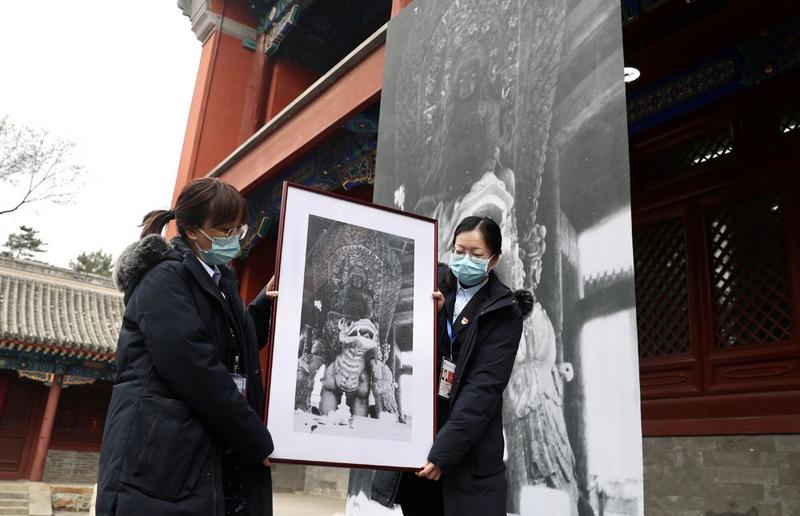 Workers from the administration of Yuanmingyuan Ruins Park exhibit a photo from the 1920s that features a statue of Manjusri Bodhisattva, a Buddhist deity, at Zhengjue Temple in Beijing, on Feb 24, 2021. (ZOU HONG / CHINA DAILY)
Workers from the administration of Yuanmingyuan Ruins Park exhibit a photo from the 1920s that features a statue of Manjusri Bodhisattva, a Buddhist deity, at Zhengjue Temple in Beijing, on Feb 24, 2021. (ZOU HONG / CHINA DAILY)
Referring to historical documents, archaeological research, scattered architectural ruins and ancient artworks portraying original scenes, people have to rely on their imagination to get an impression of the past splendor of Yuanmingyuan, or the Old Summer Palace, in Beijing.
But they may now be able to get a clearer picture of its former glory.
These findings will help people get a better understanding of how Yuanmingyuan has changed throughout history.
Li Xiangyang, Deputy director of the administration of Yuanmingyuan Ruins Park, China
On Tuesday, the administration of the Yuanmingyuan ruins released more than 360 old photos, which were collected globally in recent years. Taken after invading Anglo-French allied forces looted and burned Yuanmingyuan, these photos capture the time before the former royal resort fell into ruin over the following decades.
Most of the photos had never been publicly displayed, and around 100 of them will be exhibited over the next month at the Zhengjue Temple of the Yuanmingyuan Ruins Park.
ALSO READ: Ancient imperial site rises from the ruins
"These findings will help people get a better understanding of how Yuanmingyuan has changed throughout history," said Li Xiangyang, deputy director of the administration.
First built in 1707 and covering over 350 hectares in its heyday, this former imperial resort of the Qing Dynasty (1644-1911) is often thought of as the zenith of Chinese gardening art.
It had been continuously expanded and renovated until 1860, when it was ransacked and set ablaze by the invading Anglo-French allied forces. Up to that point, images of Yuanmingyuan had only been recorded in paintings.
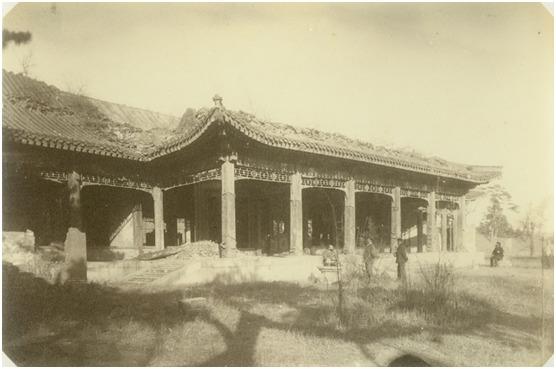 A photo of Yuanmingyuan taken by Robert de Semalle, a former French diplomat based in Beijing, in 1882. (PHOTO PROVIDED TO CHINA DAILY)
A photo of Yuanmingyuan taken by Robert de Semalle, a former French diplomat based in Beijing, in 1882. (PHOTO PROVIDED TO CHINA DAILY)
Yuanmingyuan gradually fell into ruin after it was ransacked-a collective psychological blow for the Chinese people-but written records on how this process took place are insufficient, Li pointed out.
According to Liu Yang, deputy director of the Beijing History, Geography and Folk Custom Society, who had collected the photos, some photographers visited the Yuanmingyuan ruins in the late 19th century, and their works became precious historical references showing that some sites survived in 1860 and continued to exist for some time afterward.
READ MORE: Horse-head bronze statue returns to Old Summer Palace
In 1861, 13 sites in Yuanmingyuan that partially remained were mentioned in an official Qing Dynasty report, as Liu cited.
"However, the sites were only named, and we could not specifically know how badly they were damaged in 1860," Liu said.
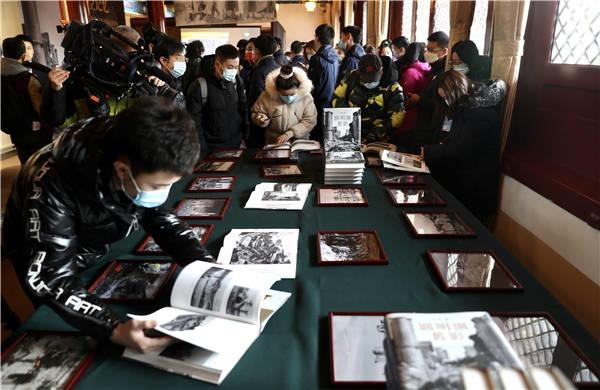 In this undated photo, visitors browse through booklets containing old photos of Yuanmingyuan at an exhibition held at the Zhengjue Temple of the Yuanmingyuan Ruins Park. (ZOU HONG / CHINA DAILY)
In this undated photo, visitors browse through booklets containing old photos of Yuanmingyuan at an exhibition held at the Zhengjue Temple of the Yuanmingyuan Ruins Park. (ZOU HONG / CHINA DAILY)
But these newly found photos provide direct clues of what actually took place after 1860. For example, in a group of photos taken in 1882 by Robert de Semalle, a French diplomat based in Beijing, many wooden constructions can be seen.
"Some of them were even in a good condition, as the photos show," Liu said.
Semalle's photographs are the first comprehensive record of surviving wooden architecture in Yuanmingyuan. Unfortunately, all of these constructions were believed to have been destroyed in war around 1900, when the Eight-Nation Alliance Force attacked Beijing.
Other key figures from the 19th century contributing to these precious photographic records include Lai Afong, a Hong Kong-based photographer, Ernst Ohlmer from Germany, Osvald Siren, a Swedish scholar, and Thomas Child, a British man who lived in Beijing for 20 years.
Thanks to them, people can now get a glimpse of how Xiyang Lou (Western Mansions)-a combination of the Western Baroque style and traditional Chinese architecture, and an iconic symbol of today's Yuanmingyuan ruins-looked in the 19th century.
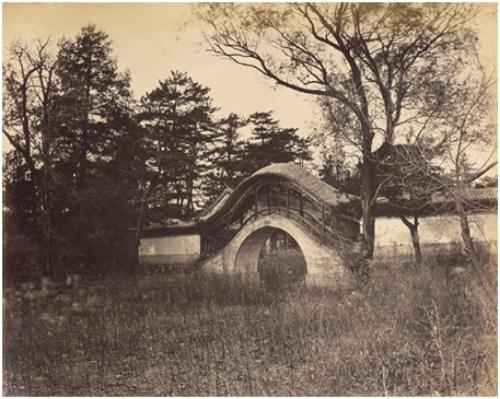 An old photo of Yuanmingyuan taken by Lai Afong, a Hong Kong-based photographer, in 1879. (PHOTO PROVIDED TO CHINA DAILY)
An old photo of Yuanmingyuan taken by Lai Afong, a Hong Kong-based photographer, in 1879. (PHOTO PROVIDED TO CHINA DAILY)
It appears that some of the structures disappeared later than people originally thought. A recently released photo from the 1920s shows an exquisite statue of Manjusri Bodhisattva, a Buddhist deity, at Zhengjue Temple, a rare example of a well-preserved structure in Yuanmingyuan. However, this statue was gone by the early 1930s.
He Yu, a history professor at Renmin University of China, said looters brought further misery to the Yuanmingyuan ruins in the early 20th century. In addition, the layout of Yuanmingyuan was also altered due to later urban development.
"All of the texts and all of our imagination could not compete with the real Yuanmingyuan represented by the photos," He said.
"The site suffered from major upheavals even after 1860. These photos not only provide abundant historical information, but also remind us of how it gradually fell into ruin."
READ MORE: Relics resurrected from palace's ruins
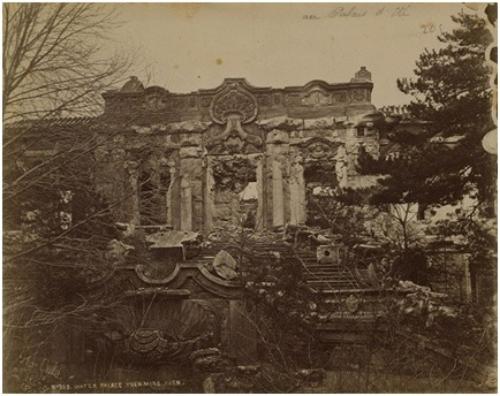 An old photo of Yuanmingyuan taken by Thomas Child, a British man who lived in Beijing for 20 years, in 1887. (PHOTO PROVIDED TO CHINA DAILY)
An old photo of Yuanmingyuan taken by Thomas Child, a British man who lived in Beijing for 20 years, in 1887. (PHOTO PROVIDED TO CHINA DAILY)
Much effort has been taken to protect Yuanmingyuan since 1976, when the administration of the ruins was established. A current focus of the administration's work is to restore the original landscape, vegetation and the layout of the waters in Yuanmingyuan, said Li, deputy director of the administration.
These photos are of immense value to people today who are striving to restore some of the former glory to Yuanmingyuan.
"These will greatly help our effort to look for lost relics and partially restore the appearance of Yuanmingyuan," Li said.
 A photo from the 1920s featuring a statue of Manjusri Bodhisattva, a Buddhist deity. (PHOTO PROVIDED TO CHINA DAILY)
A photo from the 1920s featuring a statue of Manjusri Bodhisattva, a Buddhist deity. (PHOTO PROVIDED TO CHINA DAILY)
This work is already taking place, with December's launch of the project to restore unearthed glazed tiles in the Xiyang Lou area by using some photos taken in 1873 as reference.
Li added that more old photos shedding light on the past glory of Yuanmingyuan will be publicly exhibited in the future.


